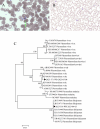A case of an asymptomatic Plasmodium falciparum infection followed by a symptomatic Plasmodium ovale infection in a soldier deployed to South Sudan
- PMID: 40211377
- PMCID: PMC11983915
- DOI: 10.1186/s12936-025-05329-2
A case of an asymptomatic Plasmodium falciparum infection followed by a symptomatic Plasmodium ovale infection in a soldier deployed to South Sudan
Abstract
Background: Asymptomatic malaria poses a significant challenge to malaria eradication efforts and delays global elimination strategies. Mixed infections are also a major concern, as they frequently relapse, increase the risk of severe malaria, require more accurate diagnosis for appropriate treatment, and contribute to the development of drug resistance.
Case presentation: A 25-year-old soldier was diagnosed with malaria following deployment in South Sudan. A comprehensive survey identified an asymptomatic Plasmodium falciparum infection, confirmed by peripheral blood smear and polymerase chain reaction (PCR). Despite being discharged after treatment, the patient developed fever and other symptoms one month later. Subsequent laboratory tests confirmed Plasmodium ovale infection based on peripheral blood smears and PCR.
Conclusion: This case underscores the importance of molecular detection for surveillance and vigilant follow-up in malaria management, particularly among patients with a history of deployment in endemic regions. The detection of P. ovale after treatment for P. falciparum highlights the need for increased awareness and testing for mixed infections to ensure effective malaria control strategies.
Keywords: Plasmodium falciparum; Plasmodium ovale; Asymptomatic infection; Malaria; South Sudan.
© 2025. The Author(s).
Conflict of interest statement
Declarations. Competing interests: The authors declare no competing interests.
Figures

Similar articles
-
Cryptic Plasmodium ovale concurrent with mixed Plasmodium falciparum and Plasmodium malariae infection in two children from Central African Republic.Malar J. 2017 Aug 15;16(1):339. doi: 10.1186/s12936-017-1979-5. Malar J. 2017. PMID: 28810865 Free PMC article.
-
Mixed Infection with Plasmodium falciparum and Plasmodium ovale in a Returned Traveller: the First Case in Korea.J Korean Med Sci. 2019 Jan 7;34(3):e23. doi: 10.3346/jkms.2019.34.e23. eCollection 2019 Jan 21. J Korean Med Sci. 2019. PMID: 30662388 Free PMC article.
-
Evaluation of the utility value of three diagnostic methods in the detection of malaria parasites in endemic area.Malar J. 2017 May 6;16(1):189. doi: 10.1186/s12936-017-1838-4. Malar J. 2017. PMID: 28477621 Free PMC article.
-
Plasmodium malariae and Plasmodium ovale--the "bashful" malaria parasites.Trends Parasitol. 2007 Jun;23(6):278-83. doi: 10.1016/j.pt.2007.04.009. Epub 2007 Apr 24. Trends Parasitol. 2007. PMID: 17459775 Free PMC article. Review.
-
Global trend of Plasmodium malariae and Plasmodium ovale spp. malaria infections in the last two decades (2000-2020): a systematic review and meta-analysis.Parasit Vectors. 2021 Jun 3;14(1):297. doi: 10.1186/s13071-021-04797-0. Parasit Vectors. 2021. PMID: 34082791 Free PMC article.
References
-
- Prusty D, Gupta N, Upadhyay A, Dar A, Naik B, Kumar N, et al. Asymptomatic malaria infection prevailing risks for human health and malaria elimination. Infect Genet Evol. 2021;93: 104987. - PubMed
-
- Nema S, Singh A, Krishna S, Poriya R, Dubey S, Ali NA, et al. Unreported mixed Plasmodium species infection may increase vivax malaria in India: a challenge for malaria elimination. Trans R Soc Trop Med Hyg. 2022;116:600–3. - PubMed
Publication types
MeSH terms
LinkOut - more resources
Full Text Sources
Medical

